
Sam Waterston, Brian Murray Star June 20 and 27
at the Metropolitan Museum in Staged Readings
of Berenson-Duveen Drama, The Old Masters .jpg) Simon Gray’s intense drama of friendship, ethics, and doom involving two leading luminaries of the pre-World War II European art world—The Old Masters—will be revived for an exclusive, two-evenings-only staged reading at The Metropolitan Museum of Art on consecutive Mondays, June 20 and June 27, at 7 p.m. The original cast from the play’s February American premiere limited engagement at the Long Wharf Theater will be re-assembled for these readings, including the award-winning actor Sam Waterston as Bernard Berenson (1865-1959) and Brian Murray as the famed art dealer Lord Joseph Duveen (1869-1939). Shirley Knight, Heidi Schreck, and Rufus Collins will also re-create the roles they originated in New Haven. Michael Rudman directs. John Martello and Elliot Martin produced the Long Wharf engagement. The drama deals with the world-renowned art historian Berenson (Waterston) and Lord Duveen (Murray), longtime associates who meet for a final, explosive encounter at I Tatti, Berenson’s villa in Florence. Unfolding in the looming shadow of the rise of Italian Fascism, the two giants conduct an epic battle over the intrinsic value of art and money, connoisseurship and profits, as they debate a putative Renaissance masterpiece, The Adoration of the Shepherds, whose attribution to Giorgione the scholar Berenson questions, insisting it is the work of his more famous student, Titian. This specialized dispute leads to the final, cathartic moments of a controversial professional relationship built on a combination of rivalry and mutual dependence. Berenson tries almost desperately to retain his reputation and influence in the final European phase of his storied career, while Duveen remains unaware that the Nazis will soon end his days as a Continental dealer and drive him to America.
The Metropolitan Museum has a long, historic connection with Lord Duveen. Over the years, the Museum acquired some 124 European paintings that passed through his gallery, among them one of the Met’s most beloved works, Francisco Goya’s late-18th-century portrait of the son of King Charles III of Spain, Don Manuel Osorio Manrique de Zuñiga, along with four Van Dycks, a Vermeer, and seven Rembrandts, including Aristotle with a Bust of Homer. Among the major Museum donors who acquired masterpieces through Duveen, and then donated or left those works to the Metropolitan, were J. P. Morgan, Benjamin Altman, Arabella Huntington, and Jules Bache. Edward Fowles, then the President of Duveen Brothers in America, donated the Duveen Archives to the Metropolitan in 1968. The Met, which used the material for decades to conduct extensive research on its Duveen acquisitions, in turn donated the trove to the Getty Research Institute in 1994. The Museum has since acquired a 450-reel microfilm copy of the archive, which is available to researchers in its Thomas J. Watson Library. Everett Fahy, former chairman of the Met’s European Paintings Department, called it “truly the most significant collection of records amassed by any art dealership based in Western Europe.” Tickets for The Old Masters are $20 for adults, $10 for students. To order, visit the Museum’s Great Hall box office, call 212-570-3949, or order from metmuseum.org/tickets.
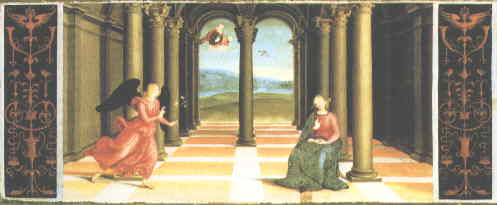
ART IN ROME: Vatican Museums include: EGYPTIAN MUSEUM
It consists of steleae and inscriptions from various ages, sarcophagi and mummies, Roman statuary (from the first and second century A.D.) designed to imitate or interpret the forms and aesthetics of Egyptian statuary, protohistoric and Roman ceramics, cuneiform tablets and mesopotamic seals, assirian bas-reliefs from the palaces of Sargon the IInd (722-705 B.C.) and Sennacherib (705-681 B.C.) in Nineveth. CHIARAMONTI MUSEUM
It was founded by Pope Pius VII (Chiaramonti) and includes: the Corridoio (Corridor), the Galleria Lapidaria and the Braccio Nuovo (New Side). In the Corridor, divide into 60 sections, is an interminable series of statues, busts, sarcofhagi, reliefs, etc: about 800 Greek-Roman works. In the Galleria Lapidaria there are over 5000 pagan and Christian inscriptions. In the Braccio Nuovo, the Statue of Augustus of Prima Porta, the Group of the Nile and the Doriforos, deserve particular attention. MUSEUM OF POPES CLEMENT XIV AND PIUS VI
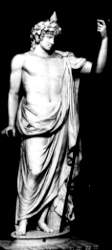 In the Palazzetto of Belvedere the visitor finds Greek and Roman sculptures like the Apollo Belvedere (a Roman copy from the original Greek sculpture, 130-140 A.D.), the famous group of Laocoön by Agesander, Polydorus and Athanodorus, the statue of Hermes (copied during Hadrian's reign from an original Greek bronze of 4th century B.C.), the colossal statue of Antinous (photo), and moreover the Canova's Cabinet, the Gallery of Statues, the Room of the Animals, etc. In the Palazzetto of Belvedere the visitor finds Greek and Roman sculptures like the Apollo Belvedere (a Roman copy from the original Greek sculpture, 130-140 A.D.), the famous group of Laocoön by Agesander, Polydorus and Athanodorus, the statue of Hermes (copied during Hadrian's reign from an original Greek bronze of 4th century B.C.), the colossal statue of Antinous (photo), and moreover the Canova's Cabinet, the Gallery of Statues, the Room of the Animals, etc. GREGORIAN MUSEUM OF ETRUSCAN ART
FThe Etruscan Museum was founded by Gregory XIV in 1837 to house the works coming from the excavations carried out in southern Etruria. It was later enriched with further acquisitions and donations, and became one of the most important for Etruscan art. ANTIQUARIUM ROMANUM
Divided into three small rooms, the Antiquarium houses mainly ancient Roman objects and works of the minor arts. VASE COLLECTION
The collection consists of Greek and Etruscan black figure ceramics. THE BIGA ROOM
This room, built during the pontificate of Pius VI (1775-99), is named after the Biga, the two-horse chariot located in the middle of the display area. The Roman Biga dates to the first century B.C. GALLERY OF THE CANDELABRA
Once a loggia, the gallery was enclosed during the pontificate of Pius VI. Arches supported by columns and pillars were used to divide the space, which was then hung with candelabra, one for each arch: hence the name of the gallery. GALLERY OF THE TAPESTRIES
Decorated during the pontificate of Pius VI, the gallery is named after the tapestries which were first exhibited there in 1814. GALLERY OF THE MAPS
The Gallery is named after the maps painted on the walls in 40 different panels, each devoted to a region, island or particular territory of Italy. APARTMENT OF ST.PIUS V
Gallery of St. Pius V: tapestries produced in Tournai in the middle of the sixteenth century and by Pieter van Aelst.
Chapel decorated with frescoes by Giorgio Vasari and Jacopo Zucchi. SOBIESKI ROOM
Named for the painting which takes up the entire north wall with its depiction of the victory of John III Sobieski, King of Poland, over the Turks outside the walls of Vienna in 1683. The work was painted by Jan Matejko (1883). ROOM OF THE IMMACULATE CONCEPTION
Located in the Borgia Tower, this room is decorated with frescoes by Francesco Podesti depicting scenes based on the dogma of the Immaculate Conception. 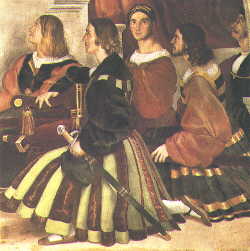 Raphael: Raphael:
The Bolsena Mass (detail)
RAPHAEL'S ROOMS AND LOGGIAS
The four rooms commonly known as the "Rooms of Raphael" were part of - togheter with the "Chiaroscuri" room, the Old Room of the Swiss, the cubicle with its adjoining heater, the Nicholine Chapel and the Loggia - the new residence chosen by Julius II on the third floor of the building.
The series of four communicating rooms was a reconstruction carried out by Nicholas V (1447-55) of the thirteenth century palace of Nicholas III (1277-80). Towards the end of the first decade of the sixteenth century Perugino, Sodoma, Baldassarre Peruzzi and Bramantino were all at work decorating them, but in 1509 Julius II dismissed them and commissioned Raphael to decorate the whole of this part of the Vatican. He worked there for about ten years, but only three of the rooms were completed before his death in 1520, and the direct intervention of the master is certain in only two of them.
COLLECTION OF MODERN RELIGIOUS ART
The collection includes Hundreds of paintings, sculptures, engravings and designs donated to the Holy See by private individuals and, in some cases, by the artists themselves. Housed in 55 different rooms, the exposition was inaugurated by Pope Paul VI in 1973. The itinerary begins in the Borgia Apartment, named for Alexander VI, who had the room decorated with the now famous frescoes, most of which are the work of either Pinturicchio or his students.
The collection includes works of Ottone Rosai, Auguste Rodin, Carlo Carrà, Mario Sironi, Aligi Sassu, Renato Guttuso, Marc Chagall, Paul Gauguin, Maurice Utrillo, Giorgio Morandi, Filippo de Pisis, Henry Moore, Paul Klee, Wassily Kandinsky, Georges Braque, Umberto Boccioni, Giacomo Balla, Giorgio De Chirico, Jacques Villon, Bernard Buffet, Oskar Kokoschka, Pablo Picasso, Francis Bacon, Diego Velasquez, etc. 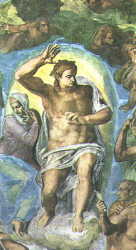 Michelangelo: Michelangelo:
Last Judgement,
Christ the Judge (detail)
SISTINE CHAPEL
Deservedly one of the most famous places in the world, the Sistine Chapel is the site where the conclave for the election of the popes and other solemn pontifical ceremonies are held. Built to the design of Baccio Pontelli by Giovannino de Dolci between 1475 and 1481, the chapel takes its name from Pope Sixtus IV, who commissioned it. It is a large rectangle with a barrel-vaulted ceiling and it is divided into two unequal parts by a marble screen. The screen and the transenna were built by Mino da Fiesole and other artists.
The frescoes on the long walls illustrate parallel events in the Lives of Moses and Christ and constitute a complex of extraordinary interest executed between 1481 and 1483 by Perugino, Botticelli, Cosimo Rosselli and Domenico Ghirlandaio, with their respective groups of assistants, who included Pinturicchio, Piero di Cosimo and others; later Luca Signorelli also joined the group.
The barrel-vaulted ceiling is entirely covered by the famous frescoes which Michelangelo painted between 1508 and 1512 for Julius II. The original design was only to have represented the Apostles, but was modified at the artist's insistence to encompass an enormously complex iconographic theme which may be synthesized as the representation of mankind waiting for the coming of the Messiah. More than twenty years later, Michelangelo was summoned back by Paul III (1534-49) to paint the Last Judgement on the wall behind the altar. He worked on it from 1536 to 1541.
APOSTOLIC LIBRARY
The Vatican Library was founded by Nicholas V (1447-55). Sixtus V (1585-90) commissioned the present building from Domenico Fontana, who built the long gallery and the Salone. VATICAN PICTURE GALLERY
The Vatican Picture Gallery was founded by Pope Pius VI (1775-99). Only in 1932 was a permanent site established in a building commissionated by Pius XI (1922-39) from a design by the architect Luca Beltrami.
The gallery includes works of Giotto, Gentile da Fabriano, Beato Angelico, Perugino, Pinturicchio, Leonardo, Tiziano, Guercino, van Dyck, Poussin, etc. GREGORIAN MUSEUM OF PROFANE ART
The special building constructed to house the museum (founded by Gregorius XVI in 1844) runs parallel to the Pinacoteca and was opened in 1970. The works are arranged according to didactic criteria, liberated as far as possible from arbitrary integration and excessive restorations. The four sections contain Roman copies and re-elaboration of Greek originals, Roman sculptures of repubblican and early imperial periods, sarcophagi, later Roman sculptures. CHRISTIAN MUSEUM
Founded in 1854 by Pius IX in the Lateran Palace to house the Christian antiquities found during the excavations of the catacombs, the Museo Pio Cristiano was transferred to the Vatican in 1963. MISSIONARY MUSEUM OF ETHNOLOGY
The material is vast and various and is presented according to didactic principles so as to document the religious cult of the various civilisation which have flourished in other continents over an enormous span of time, from centuries before the coming of Christ right up to our times. CARRIAGE PAVILION
It was founded under the auspices of Paul VI and laid out in 1973 in a building constructed under the Square Garden.
The collection contains: the carriages of popes and cardinals, with various harnesses; graphic and photographic documentation of solemn processions containing berlins and carriages; black landaus for daily conveyance and the first automobiles used by the popes.
In the global race to erect iconic structures that command attention and therefore tourists, the city of Seville, Spain, recently opened the Metropol Parasol, an inventive wooden canopy of six interconnected parasols, built using fire-treated wooden beams. The Berlin-based architect Jürgen Mayer H., who is 45, designed the open-air structure after winning an international competition with his stated intention to build a “cathedral without walls,” which he proposed situating amid the Plaza de la Encarnación’s preserved Roman ruins. An air-conditioned interior market bustling with fishmongers and meat and produce vendors is open for business, as are restaurants, concessions stands, shops and a podium for concerts and events. It’s still too early to tell whether the Metropol Parasol’s growing renown will help revitalize a struggling local economy, but it has succeeded on one count: it is making headlines. 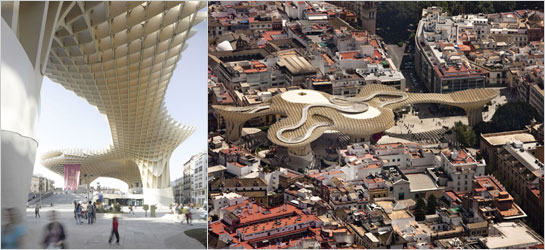

Rare View of Creation of Sand Mandala Held at SBMA Monks from Sera Mahayana Buddhist Monastery Built Mandala in Davidson Gallery of the Santa Barbara Museum of Art Over a Six-Day Period The creation of the Compassion Sand Mandala, a sacred symbol used as a meditational aid in Buddism, took place from May 17-21 and was open to public viewing. The mandala created at SBMA was done with colored sand, and was dedicated to the deity Chenrezig. The Tebetan name for Bodhisattiva Avalokitesvara. Chenrezig is the embodiment of compassion that is central to the teachings of Mahayana Buddhism.
On Sunday May 22 following public viewing the Mandala was dismantled in a ceremony and the Sera Mahayana Buddhist Monks walked the Mandala to the beach to deposit sand into the ocean. 850 visitors attended the closing ceremony. Tradition requires that it be immediately dismantled and the sand returned into local waters. This dismantling signifies the Buddhist teachings of impermanence and nonattachment. This event was part of a series in anticipation of the completion of the renovaton of the Museum’s Asian Galleries and was co-sponsored by the Museum’s Friends of Asian Art and the Department of Religious Studies at UCSB. Additional support was provided by Jose Cabezon, Jordan Robinson and China Pavillion Restaurant. The Santa Barbara Museum of Art is a privately funded, not-for-profit institution that provides internationally recognized collections and exhibitions and a broad array of cultural and educational activities as well as travel opportunities around the world. Visit: www.sbma.net.
|





